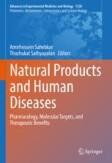Search
Search Results
-
Role of Herbal Medicines in the Management of Brain Injury
Brain is susceptible to oxidative stress due to its increased oxygen consumption and low antioxidant levels. Oxidative stress plays a crucial role in...
-
Omega-3 Fatty Acids and Ageing Brain
Inflammation plays a key role in the pathogenesis of age-related brain diseases. Hence, it is appropriate to target inflammation for disease...
-
The Phytoestrogenic Effect of Hibiscus sabdariffa Involves Estrogen Receptor α in Ovariectomized Wistar Rats
The calyxes of Hibiscus sabdariffa present multiple pharmacological effects primarily attributed to their high anthocyanin content; however, little...

-
Enhanced antidepressant effects of BDNF-quercetin alginate nanogels for depression therapy
BackgroundBrain-derived neurotrophic factor (BDNF) with neuronic development and function is a promising therapeutic agent for treating depressive...

-
Intranasal Nose-to-Brain Drug Delivery via the Olfactory Region in Mice: Two In-Depth Protocols for Region-Specific Intranasal Application of Antibodies and for Expression Analysis of Fc Receptors via In Situ Hybridization in the Nasal Mucosa
A region-specific catheter-based intranasal administration method was successfully developed, established, and validated as reported previously. By...
-
Chrysophanol improves memory impairment and cell injury by reducing the level of ferroptosis in Aβ25–35 treated rat and PC12 cells
Alzheimer’s disease (AD) is a common age-related chronic and neurodegenerative disease that has become a global health problem. AD pathogenesis is...

-
Inhibition of FLT1 Attenuates Neurodevelopmental Abnormalities and Cognitive Impairment in Offspring Caused by Maternal Prenatal Stress
Fms-like tyrosine kinase 1 (FLT1) has been shown to regulate processes such as angiogenesis, neurogenesis, and cognitive impairment. However, the...

-
The Role of Nrf2-ARE Signaling Pathway and Tatarinow Sweetflag Extract to Regulate the Acute Phase of Pilocarpine-Induced Epilepsy in Juvenile Rats
To analyze the role of Nrf2-ARE signaling pathway in the regulation of the acute phase of pilocarpine-induced epilepsy in juvenile rats by Tatarinow...

-
Stem Cells in CNS and Cardiac Regeneration
The central nervous system (CNS) and the heart muscle regenerate poorly after injury, yet evidence is mounting that both harbor cells capable of...
-
Exposure to two-dimensional ultrathin Ti3C2 (MXene) nanosheets during early pregnancy impairs neurodevelopment of offspring in mice
BackgroundTwo-dimensional ultrathin Ti 3 C 2 (MXene) nanosheets have been extensively explored for various biomedical applications. However, safety...

-
Improvement effects of cyclic peptides from Annona squamosa on cognitive decline in neuroinflammatory mice
Cyclic peptides can resist enzymatic hydrolysis to pass through the intestine barrier, which may reduce the risk of mild cognition decline. But...

-
Brain-targeted nanoreactors prevent the development of organophosphate-induced delayed neurological damage
BackgroundOrganophosphate (OP)-induced delayed neurological damage is attributed to permanent neuropathological lesions caused by irreversible...

-
Modeling Anorexia Nervosa
Although the pathophysiology underlying anorexia nervosa (AN) has not been fully elucidated, inflammation appears to be a critical component of its...
-
Comparative evaluation of natural neuroprotectives and their combinations on chronic immobilization stress-induced depression in experimental mice
The present study evaluates the potential of neuroprotective phytochemicals-rutin (R), resveratrol (Res), 17β-estradiol (17β-E2), and their different...

-
An Introduction: Overview of Nervous System and Brain Disorders
Cells are the basic structural and functional units of living organisms, enabling a living being to perform a particular task or governing a specific...
-
Dehydrozingerone protects temozolomide-induced cognitive impairment in normal and C6 glioma rats besides enhancing its anticancer potential
Considering the cognitive impairment induced by temozolomide (TMZ) in glioblastoma survivors, the present study was aimed to evaluate the protective...

-
Age-Related Neurodegenerative Diseases
Aging is one of the major risk factors for several neurodegenerative diseases, the most common being Alzheimer’s and Parkinson’s diseases. Besides...
-
Characterization of N-glycome profile in mouse brain tissue regions by MALDI-TOF/MS
Glycosylation is one of the most common types of post-translational modifications in mammals. It is well known that N-glycans play a key role in cell...

-
Application of Lineage Tracing in Central Nervous System Development and Regeneration
The central nervous system (CNS) is a complicated neural network. The origin and evolution of functional neurons and glia cells remain unclear, as do...

-
Cellular and Neurological Effects of Lead (Pb) Toxicity
Lead (Pb2+), a naturally occurringNeurological effects common heavy metalMetal found in the earth’s crust, replaces other cations in living...
